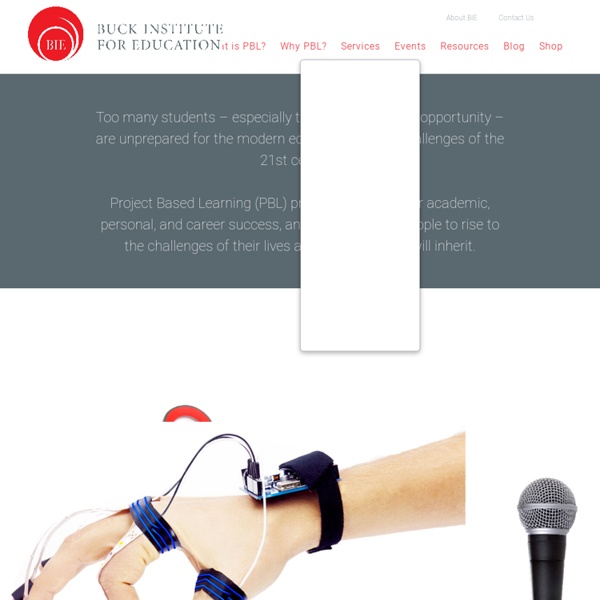



Sir Ken Robinson on “Personalized Learning” « Personalizing Learning Thank you to “PW” for posting this content as a comment on Nov. 20th–I wanted to repost to draw attention to what Sir Ken Robinson says about Personalized Learning: “Personalized learning, to me, is the process of contouring learning to the individuals that you’re dealing with, recognizing that we all have different strengths and weaknesses, different interests [and] different ways of learning.” “It isn’t that everyone has to learn different things, although eventually our interests will take us in different directions,” he continued.
9 PBL On-line Resources That Put Students At The Center… Voice, Input, Contribution Welcome to the fifth in a series of PBL Mania Posts . For the last few weeks I am celebrating Project Based Learning. In this post I will introduce you to some outstanding online tools found on the web that will put kids in the center of PBL. Before reading please take a moment to subscribe to this 21centuryedtech Blog by email or RSS and also give me a follow on Twitter at mjgormans. You will not want to miss this series or future posts involving STEM, Flipping the Classroom, Technology Integration, Common Core, and 21st Century Skills, So Sign Up Now!
Visible Thinking VisibleThinking In Action Every committed educator wants better learning and more thoughtful students. Visible Thinking is a way of helping to achieve that without a separate ‘thinking skills' course or fixed lessons. Visible Thinking is a broad and flexible framework for enriching classroom learning in the content areas and fostering students' intellectual development at the same time. Here are some of its key goals:
10 Things in School That Should Be Obsolete Flickr: Corey Leopold By Greg Stack So much about how and where kids learn has changed over the years, but the physical structure of schools has not. Definitions « Personalizing Learning CALGARY BOARD OF EDUCATION: “Key components of personalization have been identified as integrating and differentiating curriculum, development of learner profiles, flexible program delivery, technology infusion, social construction, and individual student learning plans.” learning how to learn: helping pupils develop a repertoire of learning skills and strategies to support their development as self-directed learnersassessment for learning: using a range of assessment techniques, with the emphasis on formative assessment that engages the learnerteaching and learning strategies: deploying the full repertoire of strategies, with pupil and teacher make informed decisions about which to use and whencurriculum choice: providing pupils with guided opportunities to develop individual learning pathways that develop skills rather than knowledgementoring and support: ensuring pupils have a one-to-one mentoring relationship with an adult, and benefit from peer support
Math Projects About Project-Based Learning Projects help students personalize their learning and are ideal for gaining key knowledge and understanding of content and answering the question: Where am I ever going to use this?" Among the greatest benefits of project-based learning (PBL) are gains in students' critical-thinking skills and development of their interpersonal and intrapersonal skills.
62 Ideas For Using The iPad In The Classroom [Presentation] - If you’ve got a pulse, using the iPad in the classroom is something you’re at least interested in on some level. It’s either why you’re here, something you want to understand better, or you loathe it all and want to make sure to avoid it (it’s been interesting to watch the seemingly growing throngs of Luddites decry learning technology–who knew it all could be so polarizing?) But we digress. Some of the ideas for using the iPad in the classroom in the following presentation by scribd user denag33 are better than others. Projecting an image, making music, controlling your classroom computer, using it as a mini-whiteboard, accessing information, keeping notes, blogging, tracking an IEP checklist, making an impromptu teleprompter, and creating concept maps are some of the better ones.
What’s the Best Way to Practice Project Based Learning? By Peter Skillen Project Based Learning can mean different things to different people, and can be practiced in a variety of ways. For educators who want to dive in, the good news is that a rich trove of resources are available. In order to create your own definition and practice, here are some parameters to consider. This diagram, enhanced by the critical eye of Brenda Sherry, can help you figure out what’s important to you and your students. Project Based Learning Resources (image from education-world.com) Project Based Learning (PBL) is a great way to teach students content, 21st century skills, and engage them in something fun and educational. I spoke more about PBL in an earlier blog ( and we had some great reader comments (Tech&Learning, May 2009, page 14).